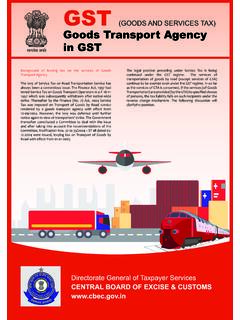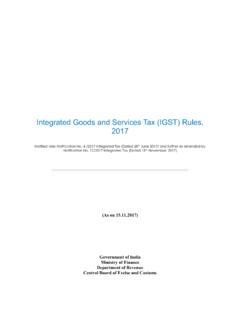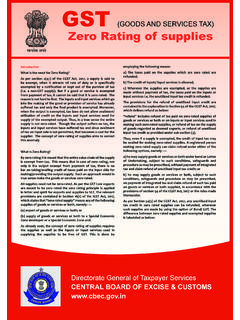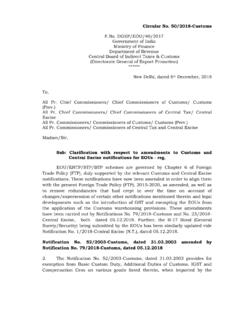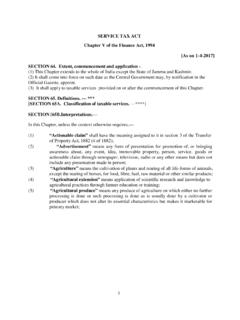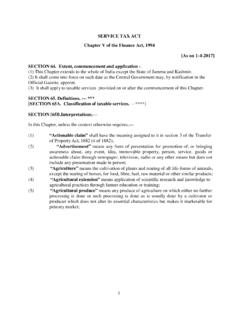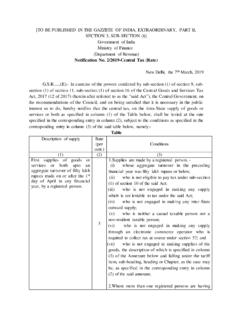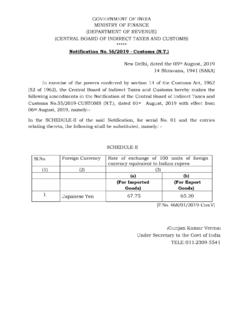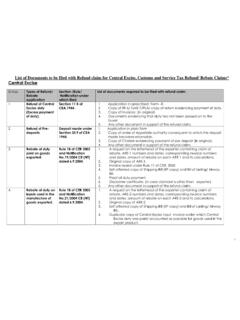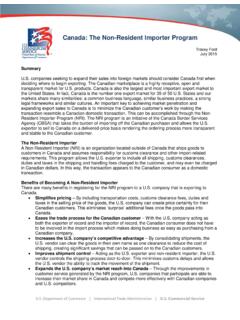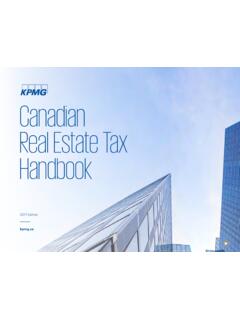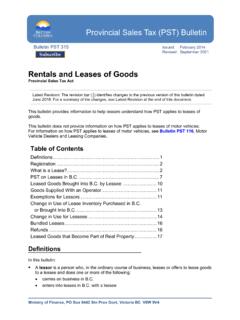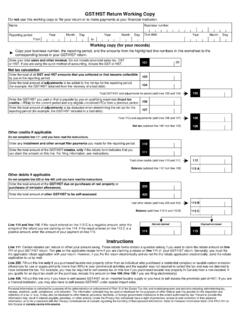Transcription of GOODS AND SERVICE TAX (GST) CONCEPT & STATUS
1 1 | 58 GOODS AND SERVICE TAX (GST) CONCEPT & STATUS CENTRAL BOARD OF INDIRECT TAXES AND CUSTOMS (CBIC) DEPARTMENT OF REVENUE MINISTRY OF FINANCE GOVERNMENT OF INDIA AS ON 01st August, 2019 2 | 58 The uniform system of taxation, which, with a few exceptions of no great consequence, takes place in all the different parts of the United Kingdom of Great Britain, leaves the interior commerce of the country, the inland and coasting trade, almost entirely free. The inland trade is almost perfectly free, and the greater part of GOODS may be carried from one end of the kingdom to the other, without requiring any permit or let-pass, without being subject to question, visit, or examination from the revenue officers..This freedom of interior commerce, the effect of uniformity of the system of taxation, is perhaps one of the principal causes of the prosperity of Great Britain; every great country being necessarily the best and most extensive market for the greater part of the productions of its own industry.
2 If the same freedom, in consequence of the same uniformity, could be extended to Ireland and the plantations, both the grandeur of the state and the prosperity of every part of the empire, would probably be still greater than at present Adam Smith in Wealth of Nations 3 | 58 1. INTRODUCTION: Whether it was uniformity of taxation and consequent free interior trade or possession of the jewel in the crown at the root of prosperity of Britain is debatable, nonetheless the words of father of modern economics on the benefits of uniformity of system of taxation cannot be taken too lightly. Before implementation of GOODS and SERVICE Tax (GST), Indian taxation system was a farrago of central, state and local area levies. By subsuming more than a score of taxes under GST, road to a harmonized system of indirect tax has been paved making India an economic union.
3 2. CONSTITUTIONAL SCHEME OF INDIRECT TAXATION IN INDIA BEFORE GST: Article 265 of the Constitution of India provides that no tax shall be levied or collected except by authority of law. As per Article 246 of the Constitution, Parliament has exclusive powers to make laws in respect of matters given in Union List (List I of the Seventh Schedule) and State Government has the exclusive jurisdiction to legislate on the matters containing in State List (List II of the Seventh Schedule). In respect of the matters contained in Concurrent List (List III of the Seventh Schedule), both the Central Government and State Governments have concurrent powers to legislate. Before advent of GST, the most important sources of indirect tax revenue for the Union were customs duty (entry 83 of Union List), central excise duty (entry 84 of Union List), and SERVICE tax (entry 97 of Union List).
4 Although entry 92C was inserted in the Union List of the Seventh Schedule of the Constitution by the Constitution (Eighty-eighth Amendment) Act, 2003 for levy of taxes on services, it was not notified. So tax on services were continued to be levied under the residual entry, entry 97, of the Union List till GST came into force. The 4 | 58 Union also levied tax called Central sales tax (CST) on inter-State sale and purchase of GOODS and on inter-State consignments of GOODS by virtue of entry 92A and 92B respectively. CST however is assigned to the State of origin, as per Central sales tax Act, 1956 made under Article 269 of the Constitution. On the State side, the most important sources of tax revenue were tax on sale and purchase (entry 54 of the State List), excise duty on alcoholic liquors, opium and narcotics (entry 51 of the State List), Taxes on luxuries, entertainments, amusements, betting and gambling (entry 62 of the State List), octroi or entry tax (entry 52 of the State List) and electricity tax ((entry 53 of the State List).)
5 CST was also an important source of revenue though the same was levied by the Union. 3. HISTORICAL EVOLUTION OF INDIRECT TAXATION IN POST-INDEPENDENCE INDIA TILL GST: In post-Independence period, central excise duty was levied on a few commodities which were in the nature of raw materials and intermediate inputs, and consumer GOODS were outside the net by and large. The first set of reform was suggested by the Taxation Enquiry Commission (1953-54) under the chairmanship of Dr. John Matthai. The Commission recommended that sales tax should be used specifically by the States as a source of revenue with Union governments' intervention allowed generally only in case of inter-State sales. It also recommended levy of a tax on inter-State sales subject to a ceiling of 1%, which the States would administer and also retain the revenue. The power to levy tax on sale and purchase of GOODS in the course of inter-State trade and commerce was assigned to the Union by the Constitution (Sixth Amendment) Act, 1956.
6 By mid-1970s, central excise duty was extended to most manufactured GOODS . Central excise duty was levied on unit, called specific duty, 5 | 58 and on value, called ad valorem duty. The number of rates was too many with no offsetting of taxes paid on inputs leading to significant cascading and classification disputes. The Indirect Taxation Enquiry Committee constituted in 1976 under Shri L K Jha recommended, inter alia, converting specific rates into ad valorem rates, rate consolidation and input tax credit mechanism of value added tax at manufacturing level (MANVAT). In 1986, the recommendation of the Jha Committee on moving on to value added tax in manufacturing was partially implemented. This was called modified value added tax (MODVAT). In principle, duty was payable on value addition but in the beginning it was limited to select inputs and manufactured GOODS only with one-to-one correlation between input and manufactured GOODS for eligibility to take input tax credit.
7 The comprehensive coverage of MODVAT was achieved by 1996-97. The next wave of reform in indirect tax sphere came with the New Economic Policy of 1991. The Tax Reforms Committee under the chairmanship of Prof. Raja J Chelliah was appointed in 1991. This Committee recommended broadening of the tax base by taxing services and pruning exemptions, consolidation and lowering of rates, extension of MODVAT on all inputs including capital GOODS . It suggested that reform of tax structure must have to be accompanied by a reform of tax administration, if complete benefits were to be derived from the tax reforms. Many of the recommendations of the Chelliah Committee were implemented. In 1999-2000, tax rates were merged in three rates, with additional rates on a few luxury GOODS . In 2000-01, three rates were merged into one rate called Central Value Added Tax (CENVAT).
8 A few commodities were subjected to special excise duty. Taxation of services by the Union was introduced in 1994 bringing in its 6 | 58 ambit only three services, namely general insurance, telecommunication and stock broking. Gradually, more and more services were brought into the fold. Over the next decade, more and more services were brought under the tax net. In 1994, tax rate on three services was 5% which gradually increased and in 2017 it was 15% (including cess). Before 2012, services were taxed under a positive list approach. This approach was prone to tax avoidance . In 2012 budget, negative list approach was adopted where 17 services were out of taxation net and all other services were subject to tax. In 2004, the input tax credit scheme for CENVAT and SERVICE Tax was merged to permit cross utilization of credits across these taxes.
9 Before state level VAT was introduced by States in the first half of the first decade of this century, sales tax was levied in States since independence. sales tax was plagued by some serious flaws. It was levied by States in an uncoordinated manner the consequences of which were different rates of sales tax on different commodities in different States. Rates of sales tax were more than ten in some States and these varied for the same commodity in different States. Inter-state sales were subjected to levy of Central sales tax . As this tax was appropriated by the exporting State credit was not allowed by the dealer in the importing State. This resulted into exportation of tax from richer to poorer states and also cascading of taxes. Interestingly, States had power of taxation over services from the very beginning. States levied tax on advertisements, luxuries, entertainments, amusements, betting and gambling.
10 A report, titled "Reform of Domestic Trade Taxes in India", on reforming indirect taxes, especially State sales tax , by National Institute of Public Finance and Policy under the leadership of Dr. Amaresh Bagchi, was prepared in 1994. This Report prepared the ground for implementation of VAT in States. Some of 7 | 58 the key recommendations were; replacing sales tax by VAT by moving over to a multistage system of taxation; allowing input tax credits for all inputs, including on machinery and equipment; harmonization and rationalization of tax rates across States with two or three rates within specified bands; pruning of exemptions and concessions except for a basic threshold limit and items like unprocessed food; zero rating of exports, inter-State sales and consignment transfers to registered dealers; taxing inter-State sales to non-registered persons as local sales; modernization of tax administration, computerization of operations and simplification of forms and procedures.
